As you can well imagine, some articles are more rewarding for a journalist to write than others. I’d put one I wrote that was just published as the cover story of Art + Auction magazine, January issue in the very rewarding category.
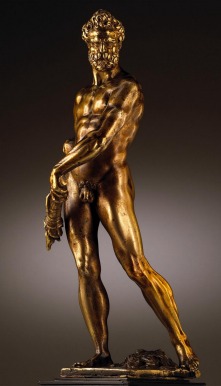 Headlined The New Allure of Old Master Sculpture, it features an area of the art market that is far too rarely noticed. Yes, you see a piece mentioning Renaissance bronzes every now and then, but that’s most of the coverage.
Headlined The New Allure of Old Master Sculpture, it features an area of the art market that is far too rarely noticed. Yes, you see a piece mentioning Renaissance bronzes every now and then, but that’s most of the coverage.
Yet it’s an exciting category, full of discoveries, re-discoveries and re-attributions (see what Eike Schmidt, curator at the Minneapolis Institute of Arts, has to say about that), and the opportunity for collectors to purchase excellent works of art at prices that are a small fraction of a comparable painting. One example I cited:
A few years ago, the Tomasso Brothers, based in Leeds and London, discovered an unknown gilt bronze of Prometheus by Giambologna (1529-1608), court sculptor to three Medici grand dukes. “The equivalent to that would be finding an unknown Bronzino portrait, which would cost £10 million,” says Dino Tomasso. Prometheus is on the market for about £1 million.
And another:
New York paintings dealer Richard Feigen tells how he was approached in 2009 by the Birmingham Museum of Art, which had received about $1 million from a donor who wanted it spent on a triptych altarpiece. “For that amount, I told them, you’d get something insignificant,” Feigen said. Instead, he steered the museum toward a marble relief by Mino da Fiesoli (1429-1484) that was in his gallery in an exhibit organized by London sculpture dealer Sam Fogg. The museum purchased the elegant portrait of a young woman in profile; it’s now the centerpiece of a gallery filled with Italian paintings.
Also interesting is who’s collecting — Old Master paintings and drawings collectors, to be sure, but also contemporary collectors, like Francois Pinault, and contemporary artists, like Damien Hirst. And of course you know about Jeff Koons.
The experts are quick to credit museum exhibitions for some of the revived interest — “Set in Stone: The Face in Medieval Sculpture” at the Metropolitan Museum in 2006-07; “Andrea Riccio: Renaissance Master of Bronze” at the Frick Collection in 2008-09, and let’s not forget “Adriaen de Vries, Imperial Sculptor” which went on view at the Rijksmuseum, the National Museum in Stockholm, and the Getty Museum in 1998-2000 — de Vries (1550-1626), though compared to Michelangelo in his day was all but forgotten soon after until that exhibition.
The cover boy was a St. Sebastian I wrote about last January for the Wall Street Journal.
Unfortunately but understandably, Art + Auction no longer posts its articles on line (at least for a few months). But you can find the issue on newsstands — not everywhere, but in enough places. I hope.
Old Master week in New York is coming at the end of this month — time to go hunting.
Â
Photo Credit: Courtesy of Tomasso Brothers

 Here’s the
Here’s the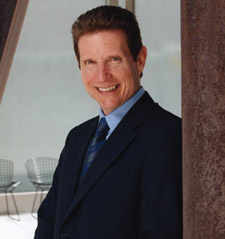 Previously, Buchanan had served as executive director of the Portland Art Museum in Portland, Oregon (1994-2005), director of Dixon Gallery and Gardens in Memphis, Tennessee (1986-1994) and executive director of the Lakeview Museum of Arts and Sciences in Peoria, Illinois (1982-1986).
Previously, Buchanan had served as executive director of the Portland Art Museum in Portland, Oregon (1994-2005), director of Dixon Gallery and Gardens in Memphis, Tennessee (1986-1994) and executive director of the Lakeview Museum of Arts and Sciences in Peoria, Illinois (1982-1986).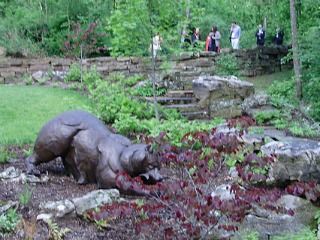 Noteworthy and, for the most part, laudable. Perhaps noting them will help counter the
Noteworthy and, for the most part, laudable. Perhaps noting them will help counter the 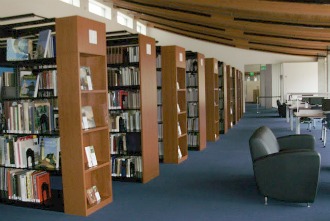 Next, the setting: Although I haven’t traversed all of the trails on the land surrounding the museum, I have on my two visits been able to walk some of them. They are lovely on their own, and while some large-scale sculptures sit on the premises (as above, Shore Lunch by Dan Ostermiller), they are sparse — so far — leaving plenty of room for nature. The building itself, which has several awkward features, does sit well in the ravine, relating to the terrain around it. Nice choice.
Next, the setting: Although I haven’t traversed all of the trails on the land surrounding the museum, I have on my two visits been able to walk some of them. They are lovely on their own, and while some large-scale sculptures sit on the premises (as above, Shore Lunch by Dan Ostermiller), they are sparse — so far — leaving plenty of room for nature. The building itself, which has several awkward features, does sit well in the ravine, relating to the terrain around it. Nice choice. And forget the uncomfortable furniture found in many libraries — Crystal Bridges offers comfortable chairs, desks and computers. Books and art periodicals have also been placed between galleries, allowing visitors to rest, to take a breather, in little lounges before taking in the next tranch of art.
And forget the uncomfortable furniture found in many libraries — Crystal Bridges offers comfortable chairs, desks and computers. Books and art periodicals have also been placed between galleries, allowing visitors to rest, to take a breather, in little lounges before taking in the next tranch of art.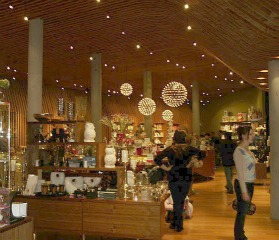 Crystal Bridges has a museum store — and a good one, very handsomely designed by Marlon Blackwell, as the photo at left attests –but it is not placed obnoxiously in front of the exit, so that all visitors must pass through it.
Crystal Bridges has a museum store — and a good one, very handsomely designed by Marlon Blackwell, as the photo at left attests –but it is not placed obnoxiously in front of the exit, so that all visitors must pass through it.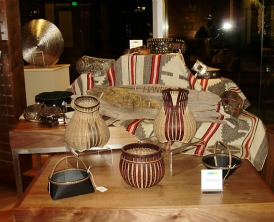 The museum also contains an auditorium, or, as it terms it, a “Great Hall” for lectures, concerts, films and other events — the one place I could not enter on either of my visits. It wasn’t finished last spring (there was only a hole in the ground then) and it was being set up for a concert when I visited in early December. The guard could not be persuaded to let me have a brief look.
The museum also contains an auditorium, or, as it terms it, a “Great Hall” for lectures, concerts, films and other events — the one place I could not enter on either of my visits. It wasn’t finished last spring (there was only a hole in the ground then) and it was being set up for a concert when I visited in early December. The guard could not be persuaded to let me have a brief look.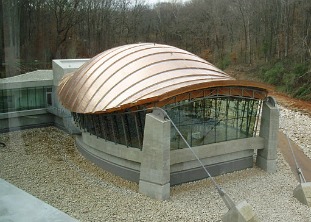 The hallway linking the main part of the museum to the Great Hall contains another admirable feature: the “community showcase.” Display cases have been inset in the walls, and area museums have been invited to place small displays drawn from their collections on view. This way, visitors to Crystal Bridges are exposed to other cultural institutions in the area, and they benefit from free publicity. Nice idea. The final photo, below, shows one of them currently on view. (Apologies for the poor picture quality. I was snapping during evening hours, which required a flash, and taking the pictures as museum visitors walked along the wall. I had to click fast.)
The hallway linking the main part of the museum to the Great Hall contains another admirable feature: the “community showcase.” Display cases have been inset in the walls, and area museums have been invited to place small displays drawn from their collections on view. This way, visitors to Crystal Bridges are exposed to other cultural institutions in the area, and they benefit from free publicity. Nice idea. The final photo, below, shows one of them currently on view. (Apologies for the poor picture quality. I was snapping during evening hours, which required a flash, and taking the pictures as museum visitors walked along the wall. I had to click fast.)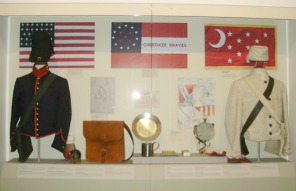 And did I mention the iPods? Visitors, upon surrender of a driver’s license or credit card, listen to guides about the collection on iPods, with Walton, museum director Don Bacigalupi and various curators providing commentary or dialogue for about two dozen works of art on view.
And did I mention the iPods? Visitors, upon surrender of a driver’s license or credit card, listen to guides about the collection on iPods, with Walton, museum director Don Bacigalupi and various curators providing commentary or dialogue for about two dozen works of art on view.![Hollan_2011_003[1].jpg](http://www.artsjournal.com/realcleararts/Hollan_2011_003%5B1%5D.jpg) When I visited Italy in November, I spent a day in Bologna, and among the places I visited was the
When I visited Italy in November, I spent a day in Bologna, and among the places I visited was the 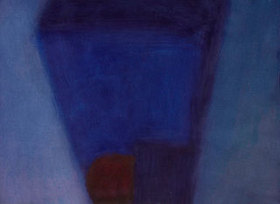 But the real revelation from my visit was not about Morandi. The museum regularly mounts temporary exhibitions for artists whose work relates to Morandi, and the exhibition I saw was for a wonderful artist I’ve never heard of: Alexandre Hollan.
But the real revelation from my visit was not about Morandi. The museum regularly mounts temporary exhibitions for artists whose work relates to Morandi, and the exhibition I saw was for a wonderful artist I’ve never heard of: Alexandre Hollan. 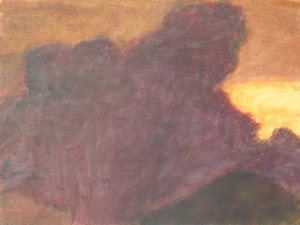 Hollan’s colors are every bit as subtle, but somehow are also richer. Many of the works are still lifes that overflow the boundaries of the paper, edging into the abstract. Mostly, he makes watercolors, gouaches, and drawings. The works on view, until Feb. 5, were made between 1984 and 2010.
Hollan’s colors are every bit as subtle, but somehow are also richer. Many of the works are still lifes that overflow the boundaries of the paper, edging into the abstract. Mostly, he makes watercolors, gouaches, and drawings. The works on view, until Feb. 5, were made between 1984 and 2010.![Hollan_2011_010[1].jpg](http://www.artsjournal.com/realcleararts/Hollan_2011_010%5B1%5D.jpg) Continuing my search, I found a few more online:
Continuing my search, I found a few more online: